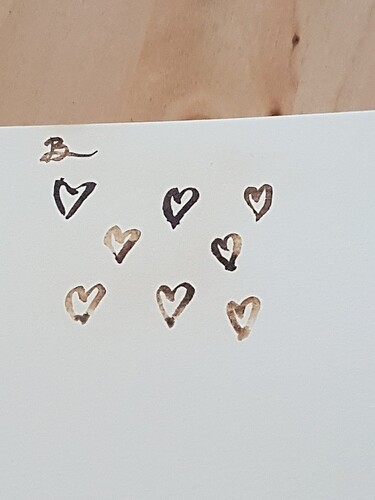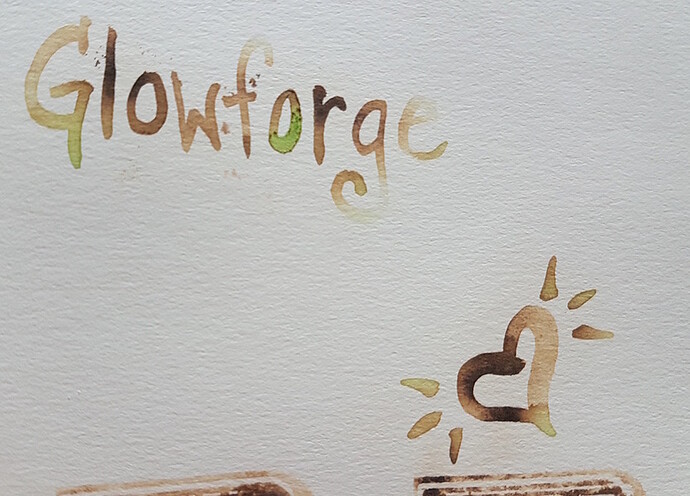My guess is a Stormtrooper or Hollywood Nazi ‘precision firing’ training film.
I put a couple heaping tablespoons in a coffee mug of water. It didn’t fully dissolve, so I believe the water was fully saturated. I don’t think the concentration has anything to do with the bleeding. It behaves exactly like water, so anything that will work better with water will work better with the ammonium chloride. I might try some thickening agents to see if they could make the water less likely to bleed while not interfering with the chemical burn.
i was thinking along those lines. i wonder how xanthan would perform…
I had to double take as it looked, to my sleep-weary eyes, like a floppy disk for a moment.
This was the original that someone got creative with.

It works nicely on paperboard too. If my stamp was spongy/absorbent instead of rubber, I expect the color would be more even. You can see how the fluid isn’t evenly distributed on the stamp even with the stamp pad.
oh, the hearts especially have an interesting effect, though; i like the pseudo-variegation on them.
Agreed. I think the color variation is what this process really has to offer.
I wanted to be able to see what I was painting, so I tried mixing using the solution with some green watercolor. I like it!
This is all amazing. Can you walk me through the technique one more time? I think I’ve puzzled it out. Ammonia chloride into water. Applied to surface. Heat gun on the wet spot? Chemistry based magic occurs. Gorgeous darkening of surface appears?
Edit: it would likely be less confusing if I could get the video to play I guess 
Yup, it’s that simple. Tiny clarification: the solution may dry before you get the heat gun to it. It doesn’t have to still be wet. Wow, I thought the video was actually at the top of the thread. Here ya go.
Would the final product be archival? I’m thinking anything that involves chloride ions is going to be likely to decompose over time.
I guess it depends on if the heat is a catalyst for an exothermic reaction that is burning the wood or not. Burn should be permanent. Other reactions less so
On heating, ammonium chloride decomposes into ammonia gas and strong hydrochloric acid (NH4Cl → NH3 + HCl). Ammonia diffuses away into the atmosphere, leaving the strong acid behind, which burns the wood. The resulting chemical burn is identical to a heat burn in most respects. (Chemical Woodburning - Make:)
I don’t know if the hydrochloric acid is burned off as you heat it or if some remains. If you’re using wood, you could wash it after, but obviously paper doesn’t leave you with that option.
i think I’m most excited with how well this works on paper, thanks for the demo
HCl is also a gas.
Uh, well that depends. It can also be a solid too. But at room temperature hydrochloric acid is normally liquid (I’m assuming you mean the acid form, since that is how one typically finds in in this instance). Pure HCl is a gas at even fairly cryogenic temps, but IIR in this case it would have combined with water in the wood, air, etc to be in the acidic form. That has a fairly high boiling point.
perhaps, and probably.
in re: solid, well, sure, okay, water is also a solid at some temperatures 
HCL is hydrogen chloride, which is a gas at room temperature. It has to combine with water to make hydrochloric acid. Hydrogen chloride gas is itself acidic but it isn’t the same as hydrochloric acid.
In practice though if it meets your lungs it will turn to hydrochloric acid and even water vapour in the air will create some.
agree, but in this specific application it is probably in acid form as I mentioned above due to combining with water in the wood, and the aqueous solution.


